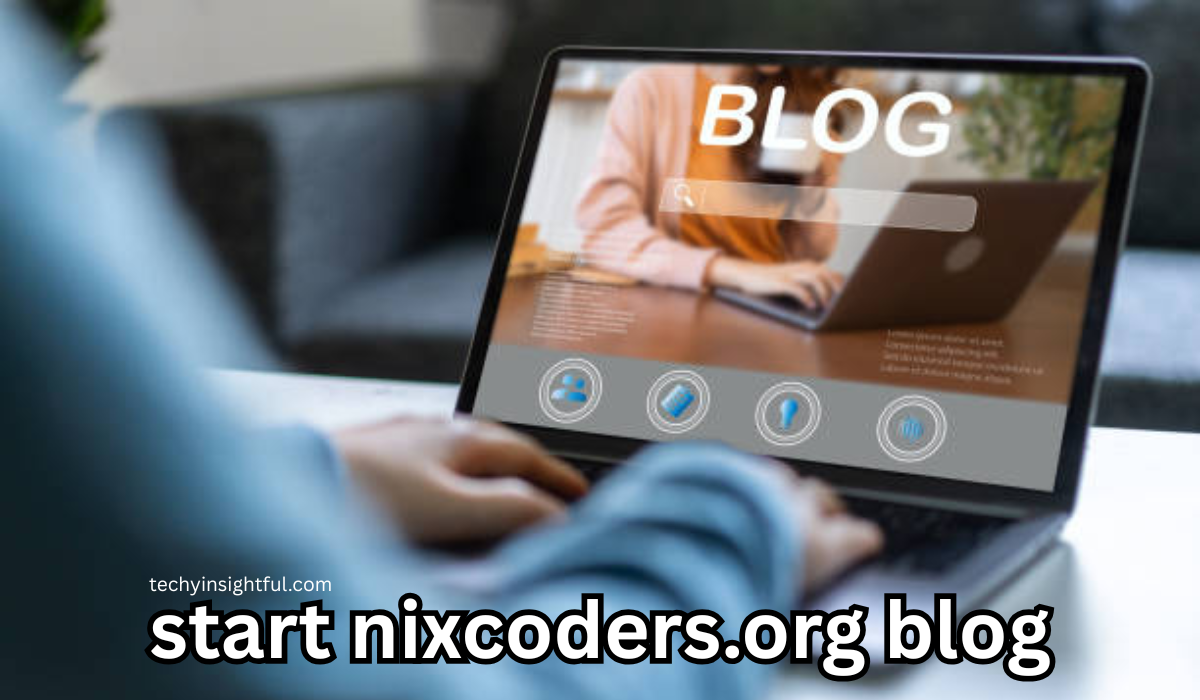
Learn how to start NixCoders.org blog with this in-depth guide. Domain setup, hosting, CMS, SEO tips, and growth strategies for tech bloggers.
Introduction
Want to start nixcoders.org blog and share your tech expertise? You’re in the right place. Launching your own blog on NixCoders.org lets you connect with developers, contribute to open-source, and build a personal brand around Linux, DevOps, or software engineering. This guide walks you step-by-step through the process—from setup to growth.
To start a NixCoders.org blog, register the domain, choose web hosting, install a CMS like WordPress or Ghost, create essential pages (About, Contact, Blog), and publish consistent tech-related content such as coding tutorials and DevOps insights.
Let’s break it down into actionable steps with tools, tips, and comparisons to help you succeed.
Why You Should Start a NixCoders.org Blog
NixCoders.org isn’t just a catchy domain name—it’s a clear brand for those passionate about Nix-based systems, Linux, DevOps, and open-source development. Owning this domain puts you in a great position to build a targeted, engaged tech audience that’s hungry for quality insights, tutorials, and resources.
Blogging under this domain lets you shape your identity in the tech space. Whether you’re a student, hobbyist, or professional engineer, your blog can serve as a portfolio, resume, or business generator. Tech readers prefer authentic voices, and your blog can be their trusted resource.
Step 1: Register the Domain NixCoders.org
If you haven’t done so yet, the first step to start NixCoders.org blog is domain registration. Choose a reliable registrar like:
-
Namecheap
-
GoDaddy
-
Google Domains
Search for “nixcoders.org” and complete your purchase. Make sure you enable domain privacy protection and set up auto-renewal to avoid losing your domain.
Step 2: Choose the Right Web Hosting
Next, pair your domain with a solid hosting provider. Web hosting is where your blog will live and load for visitors. Look for:
-
Speed
-
Uptime Guarantee (99.9%)
-
Security (SSL, backups, firewalls)
-
Ease of use
Top Hosting Providers for Tech Blogs:
| Provider | CMS Support | Speed | Price (Monthly) |
|---|---|---|---|
| SiteGround | Excellent | ⭐⭐⭐⭐ | $2.99 – $5.99 |
| Hostinger | Excellent | ⭐⭐⭐⭐⭐ | $1.99 – $4.99 |
| DigitalOcean | Advanced use | ⭐⭐⭐⭐⭐ | $5 – scalable |
| Bluehost | Beginner-friendly | ⭐⭐⭐⭐ | $2.95 – $5.95 |

Step 3: Install a Content Management System (CMS)
A CMS allows you to publish, edit, and manage your content without coding. For the NixCoders.org blog, pick one that aligns with your skills.
Recommended CMS Options:
-
WordPress – Best for ease of use and plugin availability
-
Ghost – Clean interface and fast performance for writers
-
Hugo – Static site generator ideal for developers who prefer Git
-
Jekyll – Minimalist and GitHub-compatible
We recommend WordPress for beginners and Hugo or Jekyll for advanced users.
Step 4: Set Up Essential Pages
Before posting tutorials or Linux guides, create foundational pages. This builds trust and improves SEO.
Must-Have Pages:
-
Home Page – Highlight your blog’s purpose and latest posts
-
About – Share who you are and why you built NixCoders.org
-
Contact – Include a form or email for collaborations or questions
-
Blog – Main archive for your articles
-
Privacy Policy – Especially important for collecting user data or running ads
You can create these easily using WordPress block editor or Hugo templates.
Step 5: Publish Your First Blog Post
Begin with a welcome post that introduces your blog to readers. Explain what topics you’ll cover (Linux, DevOps, cloud, etc.) and what they can expect. Use headings, bullet points, and internal links for structure.
For example:
“Welcome to NixCoders.org – a space for fellow tech enthusiasts diving into Linux servers, Docker, Kubernetes, and open-source software.”
This first post sets your tone and builds connection with early visitors.

Define a Focused Niche and Content Strategy
To rank on Google and keep readers engaged, choose a clear content direction. A niche helps search engines understand your site and builds authority faster.
Tech Niche Ideas for NixCoders.org:
-
Linux SysAdmin tutorials
-
Shell scripting guides
-
DevOps automation (Ansible, Terraform)
-
Containerization with Docker
-
Kubernetes troubleshooting
Stay consistent with content. Posting once a week or even monthly is enough if it’s high-quality and value-driven.
SEO and Keyword Research for Tech Blogs
To start NixCoders.org blog and grow it, SEO is key. Use free tools like:
-
AnswerThePublic
Find long-tail keywords like:
-
“how to configure Nginx on Ubuntu”
-
“Linux vs Windows for developers”
-
“best DevOps tools 2025”
Integrate these naturally into titles, headers, image alt text, and meta descriptions.
Plugins and Tools to Power Your Blog
If you’re using WordPress, the right plugins enhance performance and usability. Here are some essentials:
-
Yoast SEO – On-page SEO optimization
-
WP Super Cache – Improves site speed
-
UpdraftPlus – Backup plugin
-
Akismet – Spam comment blocker
-
Elementor – Drag-and-drop page builder
If using Hugo or Jekyll, explore GitHub Actions for automated builds and deploy via Netlify or Vercel.

How to Promote Your Blog After Launch
Once you start your NixCoders.org blog, getting traffic is crucial. Use these tactics:
-
Reddit: Share in subreddits like r/linux, r/selfhosted, r/opensource
-
Dev.to: Republish articles for broader reach
-
Twitter/X: Post threads on coding concepts
-
LinkedIn: Share blog milestones and guides
-
Hacker News: Submit insightful or trending dev content
Promoting via email newsletter or Discord servers (e.g., Linux or DevOps channels) also boosts early traction.
Monetize Your NixCoders.org Blog (Optional)
While your goal may be to educate, monetizing your blog can support your time and hosting costs.
Common Tech Blog Monetization Options:
-
Affiliate marketing (e.g., Hostinger, DigitalOcean)
-
Sponsored posts or tool reviews
-
Google AdSense or Ezoic
-
Sell eBooks or Linux cheat sheets
-
Offer freelance DevOps services
Ensure all monetization is ethical, relevant, and useful to your tech audience.
Maintain and Improve Your Blog
Blogging isn’t a one-time setup. Keep your blog healthy and growing with:
-
Regular plugin/theme updates
-
Weekly or monthly post publishing
-
Keyword refreshes for older content
-
Google Search Console and Analytics reviews
-
Page speed optimization (via GTmetrix or PageSpeed Insights)
Consistency builds authority in the tech niche over time.
Conclusion
Creating your blog on NixCoders.org gives you a voice in the developer world. You can educate others, build your network, and showcase your expertise. With the steps outlined above, you can go from idea to live blog with confidence. Stay consistent, publish what you know, and keep learning.
Ready to build your tech brand? Register your domain, install your CMS, and publish your first NixCoders.org blog post today.
FAQs: Starting NixCoders.org Blog
1. Is WordPress or Hugo better for NixCoders.org?
WordPress is beginner-friendly and highly customizable. Hugo offers more speed and developer control. Choose based on your experience level.
2. How much does it cost to run a blog yearly?
Expect $50–$100 annually for domain + hosting. Extras like themes or premium plugins can increase costs.
3. How often should I post on NixCoders.org?
Once a week or biweekly is ideal. However, monthly high-value content also works well in the tech space.
4. Do I need to code to start NixCoders.org blog?
No. WordPress doesn’t require coding. If you use Jekyll or Hugo, basic HTML/CSS/Git knowledge helps.
5. Can I use GitHub Pages for NixCoders.org?
Yes, if using Jekyll or a static site generator. You’ll need to configure DNS for a custom domain.
Read also: consultant wiufamcta jivbcqu AI-Powered Strategic Consulting






